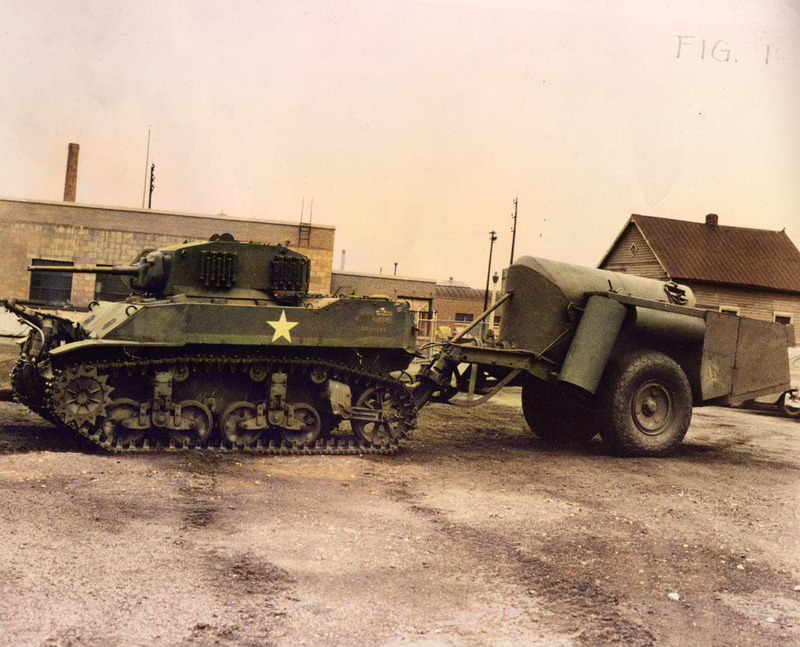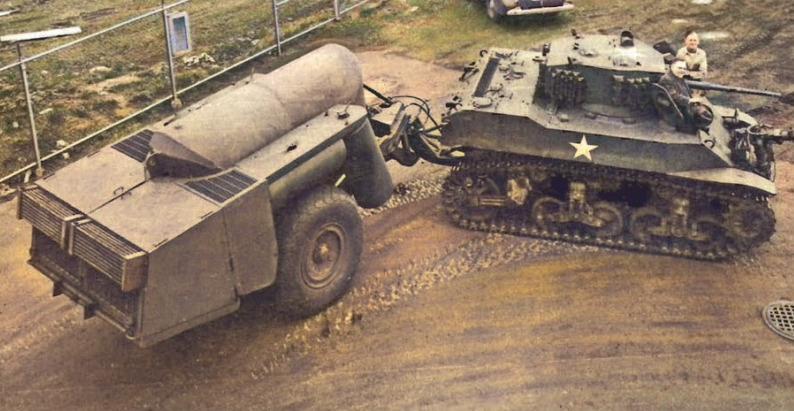- Yes
- No

Mounting E9-9 Flamethrower
Background
Spoiler
In April of 1943, the Standard Oil Company of Indiana was contracted to develop a new flamethrower for the M5A1. The M5A1 chosen was one of the late production variants, which identifiably excludes the pistol ports located on either side of the turret. The objective of the contract was to produce a flamethrower with a large fuel capacity, a range of around 182 m, and would not take away from the M5A1’s anti-tank capability. The idea for the project would be for use in the Pacific Theatre
The E9 was designed to fit the flamethrower component into the M5A1 whilst all other components would be mounted on a trailer roughly the size of the tank itself. The trailer itself was connected to the M5A1 via a 254mm Socket, with this connection point the M5A1 was only able to make turns of 105°. The fuel line passed through this joint, and special valves were manufactured which allowed the M5A1 to jettison the trailer without any fuel spilling from the tank.
Unfortunately, the testing phase of the E9 was never completed. During one of the tests a compressor failure occurred and shortly thereafter the trailer exploded, which was followed by the M5A1 being swallowed by flames. Catastrophically, All 4 crew members burnt to there death, and 9 more were wounded by the explosion. studies after the explosion revealed faults in the tanks designed, it was poorly welded, didn’t meet industrial standards, and the weakened springs and oil deposits of the compressor resulted in its valve to stick open, which later resulted in ignition of said oil buildup. following this, the development of the project was canceled as the trailer was completely destroyed, the pilot vehicle was damaged beyond repair, and with the passing of the crew, interest in the project was dropped.
Technical Data
Tank Specifications
Crew - 4
Length - 4.8387 m
Width - 2.286 m
Height - 2.5654 m (Including MG Mount)
Tread - 1.86182 m
Fire Height - 1.96596 m
Ground Clearance - 0.4191 m
Powerpack - Twin Cadillac Serie 42 (8 x 2) Cylinder Engines
Net kW - 164.054 kW at 3,400 rpm
Net Torque - 661.639 Joule
Fuel - 80 Octane Gasoline.
Combat Weight - 15,195.344 kg
Combat Weight w Trailer - 26,081.64 kg
Power to Weight Ratio - 0.010796 kW/kg (13.1 Hp/Ton)
Power to Weight Ratio W Trailer - 0.00629 kW/kg (7.65 Hp/Ton)
Transmission - Hydramatic, +4 / -2
Maximum Speed 57.9364 km/h
Maximum Speed with Trailer - 55.1 km/h
Turret Ring Diameter - 1.18745 m (Inside)
Max Turn Angle - 105°
(Note that it is possible for the Trailer to be jettisoned from inside the Stuart)
Armor
Hull Composition - Rolled Homogeneous Steel
Assembly - Welded
UFP - 28.58mm
LFP (Cast) - 38 ↔ 64mm
Sides - 25mm
Rear - 25mm
Roof - 13mm
Floor - 9.53 ↔ 13mm
Turret Composition- Rolled Homogeneous Steel
Gun Mantlet - 51mm
Front - 44.5mm
Sides - 31.8mm
Read - 31.8mm
Roof - 13mm
Trailer Specifications
Length - 4.3 ~ 4.6 m (Artificially Measured)
Width - 2.2 ~ m (Artificially Measured)
Height - 2.6 ~ m (Artificially Measured)
Tank Maximum Fill - 5,455 Litre
Tank Normal Fill - 3,637 Litre
Air Compression - 800 PSI
Trailer Combat Weight - 10886.2 kg
Armament
1 x 37mm M6 Cannon in M44 Mount
Ammo - M74B1, M51B1, M63, M2
RoF - 30 rpm
Traverse - 360° / +20° / -12° (15 Seconds for full 360°)
1 x 7.62mm MG M1919A5 in Coaxial Mount
Ammo - ~2,250 Rounds (Estimation)
RoF - 535 rpm
Traverse - 360° / +20° / -12° (15 seconds for full 360°)
1 x E9 Flamethrower in Bow Mount
Fuel - 3,367 Litre’s of Napalm Thickened Gasoline.
Range - 182.22 m
RoF - 29.9678 Litre (19.05 mm Nozzle) 3.40687 Litre (6.35mm Nozzle) (800 psi)
Traverse - <60 / 60> / +25° / -15°
Electronics
Either SCR 508, 528, or 538 Radio. (Not documented)

Sources
Spoiler
STUART, A History of the American Light Tank, Vol 1. R.P. Hunnicutt (1992)